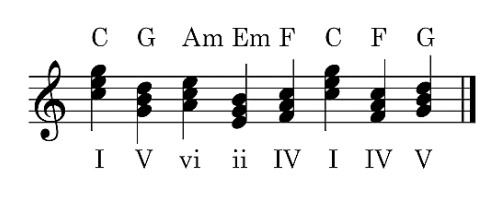It goes beyond saying that the piano has shaped the better part of modern music. It seems overwhelming to even think of the musical capabilities a piano offers.
Even if you are new to piano classes, you must have heard about piano chord progressions from your peers. Did you know that most popular Rock or Pop songs didn’t exist if there were no chord progressions?
You’ve read it right. Such is the impact of it. So, let’s throw some light on these amazing creations and the best chord progression on piano with examples of each.
What are Chord Progressions?
Chord progressions, or as some people call them, harmonic progressions, are simply a few chords played together. You need to keep in mind that chord progressions are wide apart from melodies, songs, or rhythms.
You must be wondering how the chords are chosen to be in a progression? Well, the key is the key.
Jokes apart, a piano chord progression consists of chords that are derived from the same key.
Here’s an example of a piano chord progression: I – V – vi – IV; in the key of G major.
Here, you can see the chords are represented with both uppercase and lowercase Roman numerals.
These numbers are important because, unlike normal numbers, Roman numerals can be upper case or lower case, and this lets us show if the chord they represent is major or minor.
A chord in lowercase numeral represents a minor chord. Similarly, chords in uppercase numerals represent major chords.
According to this, the chords in the above-mentioned chord progression are G major – D major – E minor – C major.
Notes According to Roman Numerals
I have discussed how you can identify a chord, whether it is a major or minor one, depending on the representation of the roman numerals.
To be more specific, these numeral signs on the stave indicate the chord’s position in relevance with the particular scale.
For example, the C major scale consists of THE FOLLOWING NOTES: C, D, E, F, G, A, B, and C. So the Roman numerals or these notes are I, ii, iii, IV, V, vi, and vii° respectively.

Quite similarly, minor keys are identified with lowercase Roman numerals.

7 Best Piano Chord Progressions
Piano chord progression structure in major keys
- I – IV – V
- I – vi – IV – V
- Ii – V – I
Here are four famous chord progressions in Major Keys –
C Major
I – IV – V (C – F – G)
I – vi – IV – V (C – Am – F – G)
Ii – V – I (Dm7 – G7 – Cmaj7)
C Sharp Major
I – IV – V (C# – F# – G#)
I – vi – IV – V (C# – A#m – F# – G#)
ii – V – I (D#m7 – G#7 – C#maj7)
D Flat major
I – IV – V (Db – Gb – Ab)
I – vi – IV – V (Db – Bbm – Gb – Ab)
ii – V – I (Ebm7 – Ab7 – Dbmaj7)
D Major
I – IV – V (D – G- A)
I – vi – IV – V (D – Bm – G – A)
ii – V – I (Em7 – A7 – Dmaj7)
Piano chord progression structure in minor keys:
- i – VI-VII
- i – iv – VII
- i – iv – v
- i – VI – III – VII
- ii – v – i
Here are three famous chord progressions in Major Keys –
A Minor
i – VI – VII (Am – F – G)
i – iv – VII (Am – Dm – G)
i – iv – v (Am – Dm – Em)
i – VI – III – VII (Am – F – C – G)
ii – v – i (Bm7b5 – Em – Am)
A Sharp Minor
i – VI – VII (A#m – F# – G#)
i – iv – VII (A#m – D#m – G#)
i – iv – v (A#m – D#m – E#m)
i – VI – III – VII (A#m – F# – C# – G#)
ii – v – i (B#m7b5 – E#m – A#m)
B Flat Minor
i – VI – VII (Bbm – Gb – Ab)
i – iv – VII (Bbm – Ebm – Ab)
i – iv – v (Bbm – Ebm – Fm)
i – VI – III – VII (Bbm – Gb – Db – Ab)
ii – v – i (Cm7b5 – Fm – Bbm)
Piano Chord Progressions Playing Tips
We all know that there’s no rule for playing music. So, it would be an exaggeration to call them rules, but these tips will make it easier for you to play chord progressions for the first time.
Tips to help you get started
- The first step is to decide the key to the particular progressions.
- Once you are done deciding, pick the most important chords in that particular key. For example, you can take the I, IV, or V chords.
- Upon deciding the chords, play them one after another on the piano and try to create a pattern of beautiful chord progression that you like.
- Here comes the ornamentation process. You need to add more chords to the progression to make it sound beautiful. You can use the vi or iii chords to make it sound more prolific.
- Don’t forget to chip in both major and minor chords regardless of what your key is.
Types of Piano Chord Progressions
Just like different genres of music, there are numerous types of chord progressions according to different moods and genres of music.
From the inception of the modern piano, pianists have been using chord progressions as a tool for evoking different moods to make you feel a certain way.
One of the greatest composers of our time, Hans Zimmer, used chord progressions on the title track of the movie ‘Interstellar’ to create a melancholic ambiance.
No worries, once you master the chord progressions, you can also use them in your music to stylize it or evoke emotions.
Here are the most popular types of piano chord progressions:
1. Pachelbel’s Canon Chord Progression

This is the most common type of piano chord progression. I am not exaggerating, but modern pop music is incomplete without this.
Pachelbel’s Canon chord progression is used in Maroon 5‘s one of the most popular songs, ‘Memories.’ The best part is that Pachelbel’s Canon chord progression is easily recognizable and easy to play.
2. 12-bar Blues Chord Progression

You must have heard about the 12-bar blues chord progression if you have ever played the piano. Such is its impact and popularity.
This chord progression became immensely popular during the emergence of the Rock and Roll genre around the 1950s.
Most of the iconic Rock and Roll songs have used this chord progression extensively for their upbeat and cheerful music.
From The Beatles to U2 and from Elvis Presley to Rolling Stones, most major artists around the 1950s and 60s used this progression in their songs.
Check out EnthuZiastic piano classes for a personalized piano learning experience.
Cheerful Piano Chord Progressions
As I have already said before, piano chord progressions are used to create and provoke certain emotions. One of the most common cheerful chord progressions is the ‘I – vi – IV – V.’
Again popularised in the 1950s, this cheerful chord progression made its way into many popular rock and roll songs.
Unlike the 12-bar blues, this progression is evolving every day with the evolving music genres.
From early Rock and Roll to modern-day pop, you will frequently find these chords in popular songs.
For example, ‘Come Together’ by The Beatles and ‘Believer’ by Imagine Dragons perfectly blended this chord progression in their composition.
How to Create Cheerful Chord Progressions?
- First of all, play a few chords that sound similar and try to understand the patterns.
- Once you have selected 4 chords, make sure that you start with a major chord and keep at least one minor chord in the progression to keep a balance in tune.
- Don’t forget to pick the chords from the same key.
- A simple trick: listen to your favorite happy and upbeat songs and try to understand the underlying chords. Feel free to use them and innovate your own music.
Melancholic Chord Progressions
You already know that most of the chord progressions ideally consist of a few major and minor chords. But there are chord progressions with all four minor chords, and obvious, they sound odd and dark.
These progressions are often used in horror movies to create tension. Just like a cheerful progression, a melancholic one is also made of a few minor and major chords.
For example, A major chord progression and F# major chord progression are the most popular melancholic/sad chord progressions on piano.
How to Create Melancholic Chord Progressions?
- The key to making a sad chord progression is minor chords. For instance, you can pick between A Minor and D Minor.
- Use major chords, but don’t overcrowd the progression with them.
- Again, listen to your favorite melancholic songs and try to read the underlying chords in them.
FAQs
What is the strongest piano chord progression?
The strongest chord progressions are the ones made of major keys. There are specific chords, like the I, IV, and V chords which are considered the strongest chords for any piano chord progression arrangement.
What is the most popular chord progression?
The I–V–vi–IV chord progression is the most popular chord progression out there. This chord progression is very famous among rock musicians. From Elvis Presley to John Lennon, modern-day musicians like Coldplay and Taylor Sift have extensively used this chord progression in their music.
Can you use any chord in any key?
Yes, you can. But it is a tricky process. Most of the chord progressions are based on the same key. However, if you want to use any
Learn Piano From Expert Teachers
Conclusion
Now that you have learned about piano chord progressions, you must be humming your favorite songs.
So, what are you waiting for? Hold the right posture and start playing a few chord progressions.
If you want to create your own chord sequences, you better learn how to play the piano by ear.
Live in music, and it will bear beautiful tunes into your life.

